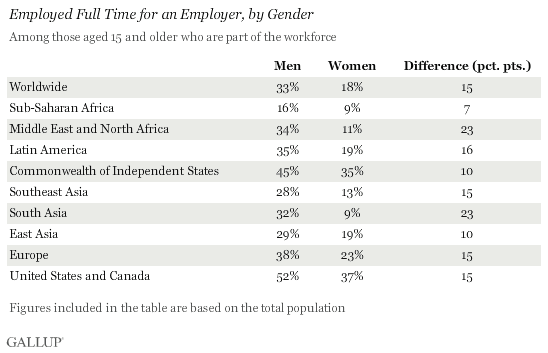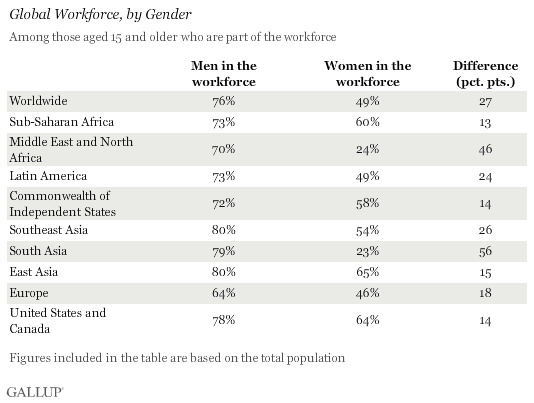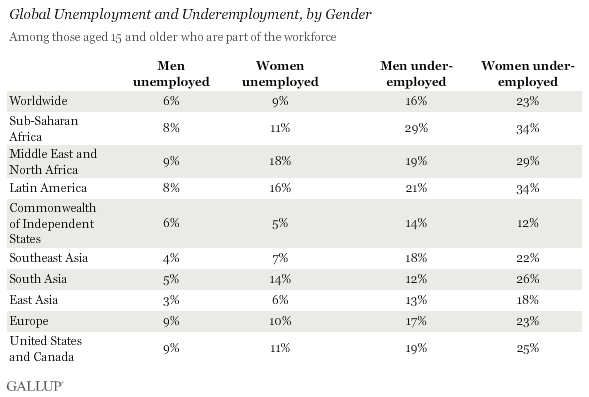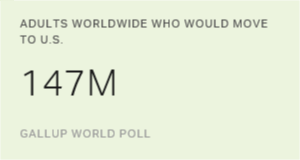WASHINGTON, D.C. -- Worldwide, men are nearly twice as likely as women to have "good jobs" that are linked to better well-being. According to Gallup surveys in more than 130 countries, 33% of the worldwide population of adult males is employed full time for an employer versus 18% of all women.

Full-time employment for an employer is Gallup's global measure of "good jobs." The metric strongly relates to a country's GDP per capita and its residents' higher well-being. Gallup defines respondents as employed full time for an employer if they work at least 30 hours per week for an employer.
Employment varies widely by region, but men are more likely than women to be employed full time for an employer everywhere. The "good jobs" gap between men and women is widest in the Middle East and North Africa and South Asia, where men are at least three times as likely as women to be employed full time for an employer. In each of these regions, however, less than one-quarter of women are part of the workforce.
Worldwide, women are generally less likely than men to be members of the workforce. About half of women (51%) are out of the workforce -- meaning they are not working and are not available for work nor looking for it. These women may be retired, students, or homemakers, although some of them may not fit any of these criteria. In comparison, about one in four men are out of the workforce.

About half of women (49%) are in the workforce -- meaning they are either working or available for work or actively looking for it. Slightly more than three in four men (76%) fall into this category. Women's more limited participation in formal employment highlights areas where large segments of the potential workforce are not being maximized. This could potentially have economic implications for the countries with large employment disparities between genders. It is important to note that large labor force participation does not necessarily mean that good jobs are widely available in a country or region. Further, in many developing societies, women shoulder the responsibility for child rearing and housework. An increase of good jobs does not guarantee women will step out of their current roles.
Women in the Workforce More Likely to Be Underemployed
Women who are part of the workforce are more likely than men to be unemployed and underemployed. Nine percent of women are unemployed -- which Gallup defines as not working and available and actively looking for work -- while about 6% of men fall into this category. Nearly one in four women (23%) are underemployed -- meaning they are unemployed or working part time and desiring full-time work -- while about one in six men (16%) are underemployed.

Women's underemployment is highest in sub-Saharan Africa and Latin America, where one in three women in the workforce are working at less than capacity. Underemployment is lowest in the Commonwealth of Independent States (CIS) and East Asia, where men and women experience relatively low rates of underemployment. The CIS area is the only region in the world where women are less likely than men to be underemployed.
Implications
Labor force participation has important economic and societal benefits for individuals and for countries. For individuals, a good job can provide economic independence and the ability to participate more fully in society and improve well-being. Good jobs may also provide protections, such as insurance and labor rights, that other jobs do not.
Good jobs drive economic growth. Countries with large percentages of women and youth out of their workforce are not maximizing a major segment of the population that could contribute to economic growth. These countries must focus on job creation and the economic participation of all segments of society.
For complete data sets or custom research from the more than 150 countries Gallup continually surveys, please contact SocialandEconomicAnalysis@gallup.com or call 202.715.3030.
Survey Methods
Results are based on telephone and face-to-face interviews with approximately 1,000 adults, aged 15 and older, per survey administration. Interviews were conducted in 131 countries throughout 2009 and 2010. In many countries, the data have been aggregated. For results based on the total sample of national adults, one can say with 95% confidence that the maximum margin of sampling error ranged from a low of ±1.4 percentage points to a high of ±4.7 percentage points. For the total sample of men and the total sample of women, the margin of error is less than ±1 percentage point. The margin of error reflects the influence of data weighting. In addition to sampling error, question wording and practical difficulties in conducting surveys can introduce error or bias into the findings of survey data.
For more complete methodology and specific survey dates, please review Gallup's Country Data Set details.
